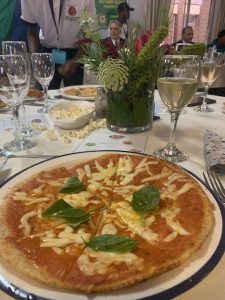

COMPETITION is unsurprisingly fierce when it comes to hosting a World Expo. While building amazing pavilions and highlighting technological and social progress, the chosen city will welcome millions of visitors, provide a link between governments and international companies, and enhance the lives of its citizens. Candidates for Expo 2030 are Busan (South Korea), Riyadh (Saudi Arabia) and Rome (Italy).
South Korea has pledged to show how the power of technology and human ingenuity can improve everyone’s life, and has appointed the famous boy band BTS as honorary ambassadors for the 2030 Busan World Expo. Remember ‘Dreamers’ and the mesmerising performance by Jung Kook, youngest member of BTS, at the opening ceremony of the FIFA World Cup Qatar 2022 opening ceremony?

Pizza Margherita with Cevico Trenbiano Chardonnay.
Saudi Arabia, a young country with 43% of its population under the age of 15, has promised to make Riyadh a venue for global culture, connectivity and climate action, should their bid to host World Expo 2030 be successful.
Italy, one of the world’s most popular tourist destinations, would like to bring World Expo 2030 to Rome. Not only a window into the past, but representing three thousand years of development, renovation and integration between faiths and cultures, Rome has come to be known as the Eternal City. The Expo 2030 Roma logo, available as an NFT digital artwork, represents an open door to the future and a new urban model based on innovation and sustainability, digital services and green spaces.
Should Busan be chosen as the host city, visitors will be treated to mouth-watering traditional Korean foods, such as beef bulgogi,
bibimbap (a rice dish), and kimchi, a sour, salty, savoury and fiery side dish made of fermented cabbage.
Visitors to Riyadh can breakfast on dates and fragrant Saudi coffee, infused with cardamom, cloves, ginger and saffron. Lunch will probably include kabsa, a flavourful rice dish, topped with roast chicken and tomato and chilli salsa, while popular beverages range from fresh mango juice and lemon mint juice to a nice tall glass of camel’s milk.
When in Rome, do as the Romans do, and indulge in a large, frothy cappuccino and a warm cornetto (similar to a croissant) for breakfast. Choices for lunch and dinner can be made from iconic favourites like pizza Napoletana, lasagne, melanzane alla parmigiana (aubergine, tomato and parmesan bake), and bistecca alla fiorentina (beefsteak grilled with olive oil and rosemary sprigs, served with lemon wedges).
Every year in November, Italian Cuisine Week is celebrated worldwide. This year the Embassy of Italy in Harare joined with SAHTC, the Hospitality School in Harare, to showcase Italy’s culinary traditions and wine connoisseurship. Celebrating the theme ‘Conviviality, Sustainability and Innovation’ the lunch took place in the Rotary Centre, and was hosted by the school’s student chefs, who served up a spectacular four course meal, with dishes representing various regions of Italy.
Smiling students in spotless uniforms met us at the door with a glass of Prosecco Botter Brut, a crisp and delicate sparkling wine from Veneto in Northern Italy, the perfect aperitivo to sip while munching a tomato bruschetta. His Excellency Mr Umberto Malnati, the new ambassador of Italy to Zimbabwe, welcomed his many guests, who included Florence Makombe, Director of Enterprises in the Ministry of Industry and Commerce.
 Pizza, generally considered to be the world’s most popular food, originated in Naples, a city in the fertile region of Campania. Served for the antipasto course, the thin crust pizza Margherita, with its simple topping of mozzarella cheese, tomato, extra virgin olive oil, salt and fresh basil, had just the right amount of charring on the edges, and was delicious.
Pizza, generally considered to be the world’s most popular food, originated in Naples, a city in the fertile region of Campania. Served for the antipasto course, the thin crust pizza Margherita, with its simple topping of mozzarella cheese, tomato, extra virgin olive oil, salt and fresh basil, had just the right amount of charring on the edges, and was delicious.
Fresh basil pesto pasta, the following course, is considered one of the most popular dishes in Liguria in northwest Italy, a region with a coastline known as the Italian Riviera. The simple ingredients of fresh basil, garlic, pine nuts, Parmesan cheese and olive oil, expertly blended and combined with corkscrew-shaped fusilli pasta, paired well with Cevico Trebbiano Chardonnay, a lovely crisp summer wine from the Emilia-Romagna wine region.
The Bionda Piemontese chicken, reared in Piedmont in north-western Italy, is highly prized for its flavour, and has given its name to a chicken salad, Insalata di Gallina Bionda. The chicken salad prepared by the students of SAHTC was also delicious, and beautifully presented. Although the salad was made with white chicken meat (bionda translates to blonde in English), it was in harmony with Cevico Rubicone IGT, an elegant, full-bodied red wine.
Sweet Zitella apple cake and tiramisu, a classic Italian dessert made from Savoiardi lady finger biscuits, cream, espresso coffee and Marsala wine, were rivalled only by the mellow tones of Mike Farrell, director of SAHTC, who stole the show with his rendition of Elvis Presley’s hit song from 1961, ‘I Can’t help Falling in Love’.
The Expo 2030 Roma logo represents the shape of a door and an arch – an open door to the future. After almost 3,000 years of history, the Eternal City cannot miss this opportunity to harness its past heritage to its vision for a sustainable future, and to host World Expo 2030.
Comments to: cmalakoff@gmail.com